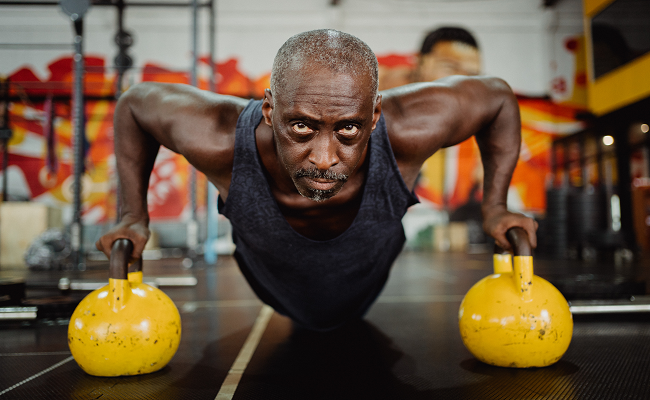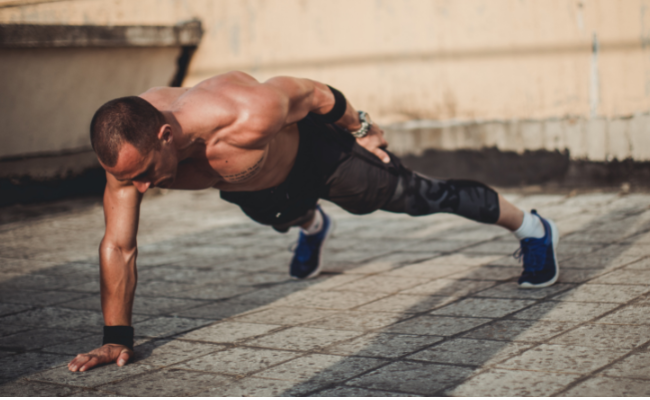If your body goal is to build strength and endurance and improve overall fitness, push-ups are for you. While others thought of this as a chest exercise, it engages several muscle groups.
Aside from the various health benefits this exercise offers, it also focuses on specific body areas. In this article, we’ll explore the many benefits of push-ups and show you how to incorporate them into your workout routine for maximum results.
Understanding the Muscles Worked by Push-Ups

Anyone serious about building muscles and fitness is no stranger to doing push-ups. Push-up exercise, like bench press, builds the upper body, strengthens the core and heart, and provides a full-body workout. How?
The exercise engages many major muscle groups that help improve posture, flexibility, and balance. Want to know what muscle push-ups work? Read on, and do push-ups for a satisfying chest and tricep exercise.
Chest and Triceps
The chest has two sets of muscles. The pectoralis major is the largest muscle, the prime mover when doing push up. It controls movement when you lower and push back the torso.
On the other hand, the pectoralis minor is smaller in size. During push-ups, this smaller chest muscle keeps the shoulder blade in position and the upper back in the correct posture.
The triceps is a sizeable thick muscle at the back of your upper arm. The lateral, long, and medial heads are the three heads of the triceps.
In addition, the radial nerve controls the movement of the tricep muscle. With push-up action, the triceps muscle helps stabilize the torso and becomes a primary mover when you extend the arms.
Performing overhead tricep extensions is a good exercise targeting tricep heads.
Shoulders
Anterior deltoids are at the topmost part of the shoulder joints. Deltoid muscles are made up of anterior, lateral, and posterior heads.
The powerful muscles help bring the arms inwardly, stabilizing the shoulders. In addition, the serratus anterior muscle helps stabilize the shoulder blades during movement.
Core
Muscles that do push-ups work also affect the core muscles or the abdominals. The core abdominal muscles work together, helping keep the spine straight while doing push-ups.
In addition, a plank push-up can strengthen the pelvic floor muscles apart from the chest, arms, and core.
Back and Biceps
During a push-up, the biceps brachii (front of the arm) engaged with the chest and shoulders. It also strengthens the lower back and core. You must do more repetitions if you want to work on your biceps.
Proper Push-Up Form for Targeting Specific Muscles
Hand Placement
Performing different push-ups requires different hand placements. Different positions put stress on other parts of the body. For instance, hand placement for the standard push-up targets the chest, shoulders, and triceps.
Hands are placed directly underneath the shoulders when doing a close-grip push-up. Placement targets the triceps and chest.
On the other hand, the wide-grip push-up with a hand position more expansive than the shoulder width targets the chest and shoulders.
Body Position
Certain body positions target different muscle groups. Doing the standard push-up targets the triceps, chest, and shoulders. Push-ups are an ideal chest and tricep workout and provide training for your chest.
For example, the incline push-up requires placing your hands on an elevated area while your feet are on the group. You need to keep your body straight.
The body position targets the triceps, chest, and shoulders. Conversely, when doing the decline, or push-up, the feet are on an elevated surface like a bench or step, and the hands are on the ground.
The upper chest and shoulders are targeted in this push-up. In addition, with a wide grip push-up, the body position targets the chest and shoulders.
Movement
You focus on specific muscle groups when you modify or do variations. Movement is vital for targeting different muscle groups.
For example, you can do a diamond push-up to target the triceps. Pike push-ups target the shoulders, while incline push-ups target the upper chest.
Tips for Maximizing Push-Up Results
Increasing Repetitions
Once your body has adjusted to the exercise, you can increase the number of repetitions. Increasing your workout load helps to keep your heart and muscles stronger.
To compute your baseline repetition count, do many push-ups in two minutes and divide by three. Keep in mind that every workout includes three sets of repetitions.
Adding Resistance
Adding resistance changes your range of motion. When you elevate your feet, you increase the resistance. Wearing a backpack filled with sandbags or a weighted vest increases resistance in a standard push-up.
Incorporating Variations
Changing hand placements during repetitions is essential when doing variations in your workout. You may start with narrow hand placement and continue with widening hand placement for the following sets.
Apart from hand placement, you can change body position to increase or decrease intensity. Challenging yourself by combining these factors helps achieve muscle growth.
Putting The Push-Up Muscle Plan into Action
Beginners Guide to Push-Ups
How to do a proper push-up:
- Be in a plank position with your hands on the floor.
- Tighten your core.
- Maintain a straight back. Inhale as you bend your elbows to descend gradually until your chest reaches the floor. Your elbows should be near your sides.
- Exhale as you push your hands toward the floor, then return to starting position.
Common Push-Up Variations
Beginner
Wall push-ups – are an excellent starting push-up for any beginner. There is less stress on the joints for this standing push-up.
Modified (knee) push-ups – this exercise focuses on balancing on the knee to build muscle strength. The knee push-up is a great beginner variation.
Intermediate
Standard Push-Up – Start with a high plank on your toes and hands, with your hands beneath your shoulders and body, forming a straight line from head to hips to heels.
Single Leg Push Up – Position in a plank with one foot off the ground.
Weighted push-up – Perform the standard push-up with a twist by wearing a weighted vest for added resistance.
Advanced
Decline Push Up – has elevated feet, creating more tension for the muscles on the chest. Movement is slightly more challenging. In addition, this variation targets the pectoralis more than a standard push-up.
One Arm Push Up – begins with a high plank, and executing it has a degree of difficulty. You perform the push-up using one hand.
Conclusion
Building muscles isn’t done overnight. Being fit and healthy takes time, energy, and a lot of effort. Finding the right push-up variations for your workout can help you achieve your ultimate body goal.
Be prepared to sweat it out and push yourself to the limit! Stay healthy!




